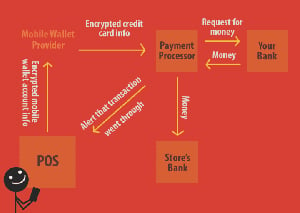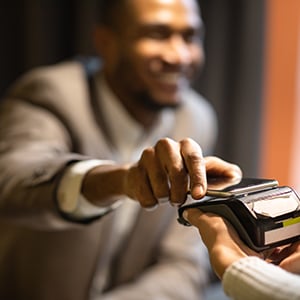Reviewed by: Jeff Norris
In today's fast-paced world, convenience and security are paramount for making payments. Digital wallets and contactless payments are now leading the way in safer, faster and more efficient shopping. These technologies offer enhanced security features and unparalleled ease of use, making them the preferred choice for modern consumers.
Mobile wallets come in various forms, each offering unique features and benefits. Here are some of the most popular types:
When you pay using a digital wallet for in-person shopping, your bank information is never vulnerable, unlike with a standard magnetic card reader. Your phone carefully encrypts your account information (not your bank, card or other payment information), which point of sale (POS) software reads through near-field communication (NFC). NFC is a technology enabling devices to establish radio communication with each other within a certain small distance.
 The POS does not read the information; instead, it sends it to the mobile wallet provider, who de-encrypts it, sees which account you want to access and checks your identifying information. Once the provider has verified your identity, they send your card information to your payment processor, who accesses your bank information and requests that your bank sends the money back to them. The payment processor then sends your money to the store's bank and alerts the POS that the transaction has been completed.
The POS does not read the information; instead, it sends it to the mobile wallet provider, who de-encrypts it, sees which account you want to access and checks your identifying information. Once the provider has verified your identity, they send your card information to your payment processor, who accesses your bank information and requests that your bank sends the money back to them. The payment processor then sends your money to the store's bank and alerts the POS that the transaction has been completed.
These features collectively make mobile wallets a safer and more secure option for managing transactions:
1. Encryption and Tokenization: Mobile wallets use encryption to protect your payment information. Tokenization replaces your card details with a unique token for each transaction, reducing the risk of fraud and unauthorized access.
2. Multi-Factor Authentication: Many mobile wallets require biometric authentication, such as fingerprint scanning or facial recognition, adding an extra layer of security.
3. Reduced Physical Contact: Contactless payments minimize the need for physical contact with payment terminals, reducing the risk of spreading germs.
Seacoast Visa® debit cards3 come with multiple layers of security to protect your transactions and personal information. One of the key features is Visa's Zero Liability Policy2, which ensures you are not held responsible for unauthorized charges. Additionally, Visa® employs advanced fraud detection systems that monitor over 500 data points per transaction to identify and prevent suspicious activities.
Visa® cards also utilize chip technology and biometric authentication methods, such as fingerprint and facial recognition to enhance security. These features collectively provide peace of mind, knowing that your Visa® debit card transactions are secure and protected against fraud.
As technology continues to evolve, so do the features and standards of digital wallets and contactless payments. Here are some of the latest advancements:
1. Biometric Authentication: Many digital wallets now support biometric authentication methods, such as fingerprint scanning and facial recognition, adding an extra layer of security to your transactions.
2. AI-Powered Fraud Detection: Artificial intelligence is being used to enhance fraud detection in digital wallets and contactless payments. AI algorithms can analyze transaction patterns and detect suspicious activities in real-time, helping to prevent fraud before it occurs.
3. Integration with Wearable Devices: Digital wallets are increasingly being integrated with wearable devices, such as smartwatches and fitness trackers, allowing for even more convenient and secure payment options.
4. Real-Time Payment Processing: The adoption of real-time payment systems is on the rise, enabling instant fund transfers and reducing the time it takes for transactions to be completed.
5. Enhanced Data Privacy: New regulations and standards are being implemented to ensure that digital wallets and contactless payment systems comply with data privacy laws, protecting users' personal and financial information.
 Setting up a digital wallet in Seacoast Mobile Banking is a straightforward process. Follow these steps to get started:
Setting up a digital wallet in Seacoast Mobile Banking is a straightforward process. Follow these steps to get started:
1. Download the Seacoast Mobile Banking App: Visit the App Store or Google Play Store and download the Seacoast Mobile Banking app.
2. Log Into Your Account: Open the app and log in using your existing Seacoast Bank online banking credentials. If you don't have an account, you can enroll here.
3. Add Your Seacoast Bank Visa® Debit Card: Navigate to the mobile wallet section within the app. Verify your Seacoast Bank Visa® Debit Card details are correct.
4. Verify Your Card: For security purposes, you may need to verify your card. This can typically be done via a one-time passcode sent to your registered mobile number or email.
5. Start Using Your Digital Wallet: After your card is verified, you can use your digital wallet. You can make contactless payments wherever mobile payments are accepted. Simply hold your device near the payment terminal and authenticate the transaction using your preferred method (e.g., fingerprint, facial recognition or PIN) and tap to pay.
Digital wallets and contactless payments are revolutionizing the way we shop, offering unparalleled convenience and security. By embracing these technologies, you can enjoy faster, safer and more efficient transactions. Learn more about adding your Seacoast Visa® Debit Card to your mobile device.
1. Apple, the Apple logo, iPad, iPhone, iPod touch, Apple Watch, Touch ID and Apple Pay are trademarks of Apple Inc., registered in the United States and other countries.
2. Visa® Zero Liability Policy covers U.S.-issued cards only. Does not apply to ATM transactions, certain commercial card transactions, PIN transactions not covered by Visa or any other transactions not processed by Visa. You must notify your financial institution immediately of any unauthorized use.
3. This card is issued by Seacoast Bank pursuant to a license from Visa® USA Inc. Visa is a registered trademark of Visa International Service Association.
Topics: Protect Your Finances, Cybersecurity Tips
Are you interested in contacting a local, Florida banker to discuss your individual financial needs? We’d love to speak with you. Schedule a consultation today.
Share: